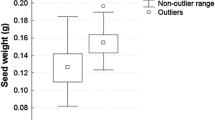Abstract
The suitability of stomata length as a criterion in the distinction between diploid and tetraploid rye-grass plants was tested.
From the data it appears that diploid and tetraploid plants can be separated with a large degree of certainty if the selection is based on the stomata length.
Samenvatting
De bruikbaarheid van stomatalengte als criterium bij het onderscheiden van di- en tetraploïde raaigrasplanten werd onderzocht.
Uit de gegevens blijkt, dat met selectie op basis van stomatalengte diploïde en tetraploïde planten met grote zekerheid gescheiden kunnen worden.
Similar content being viewed by others
References
ButterfassT., Die praktische Ermittlung des Polyploidiegrads von Zuckerrüben durch Zählen der Schliesszellen Chloroplasten. Der Züchter 28 (1958): 309–314.
ClarkeJ., Preparation of leaf epidermis for topographic study, Stain Technology 35 (1960): 35–39.
CooperD. C., Artificial induction of polyploidy in Alfalfa. American Journal of Botany 26 (1939): 65–76.
DudleyJ., Number of chloroplasts in the guard cells of inbred lines of tetraploid and diploid sugar beets. Agronomy Journal 50 (1958): 169–170.
EvansA., The production and identification of polyploids in red clover, white clover and lucerne. The New Phytologist 54 (1955): 149–162.
FrandsenK. J., Iagttagelser over polyploide Former af nogle Kulturplanter. Tidskrift for Planteavl 49 (1945): 445–496.
FunkeC., Eine Schnellmethode zur Selektion polyploider Pflanzen. Die Naturwissenschaften 43 (1956): 66.
LevanA., Framställning av tetraploid rödklöver. Sveriges Utsädesföreningens Tidskrift 50 (1940): 115–123.
MochizukiA., and M.Sueoka, Genetic studies on the number of plastids in stomata-I. Effects of autopolyploidy in sugar beets. Cytologia (Tokyo) 20 (1955): 358–366.
RandolphL. F., E. C.Abbe and J.Einset, Comparison of shoot apex and leaf development and structure in diploid and tetraploid maize. Journal of Agricultural Research 69 (1944): 47–76.
RandolphE. C. and J.Einset, Development pattern of the leaf blade in 2n and 4 n Zea maize as related to the structure of the growing point. American Journal of Botany 26 (1939): 26–45.
SchwanttzF. Einige kritische Bemerkungen zur Methode der Bestimmung der Polyploidie durch Messung der Pollen und Spaltöffnungsgrösse. Der Züchter 22 (1952): 273–275.
Author information
Authors and Affiliations
Rights and permissions
About this article
Cite this article
Speckmann, G.J., Post, J. & Dijkstra, H. The length of stomata as an indicator for polyploidy in rye-grasses. Euphytica 14, 225–230 (1965). https://doi.org/10.1007/BF00149503
Received:
Issue Date:
DOI: https://doi.org/10.1007/BF00149503




